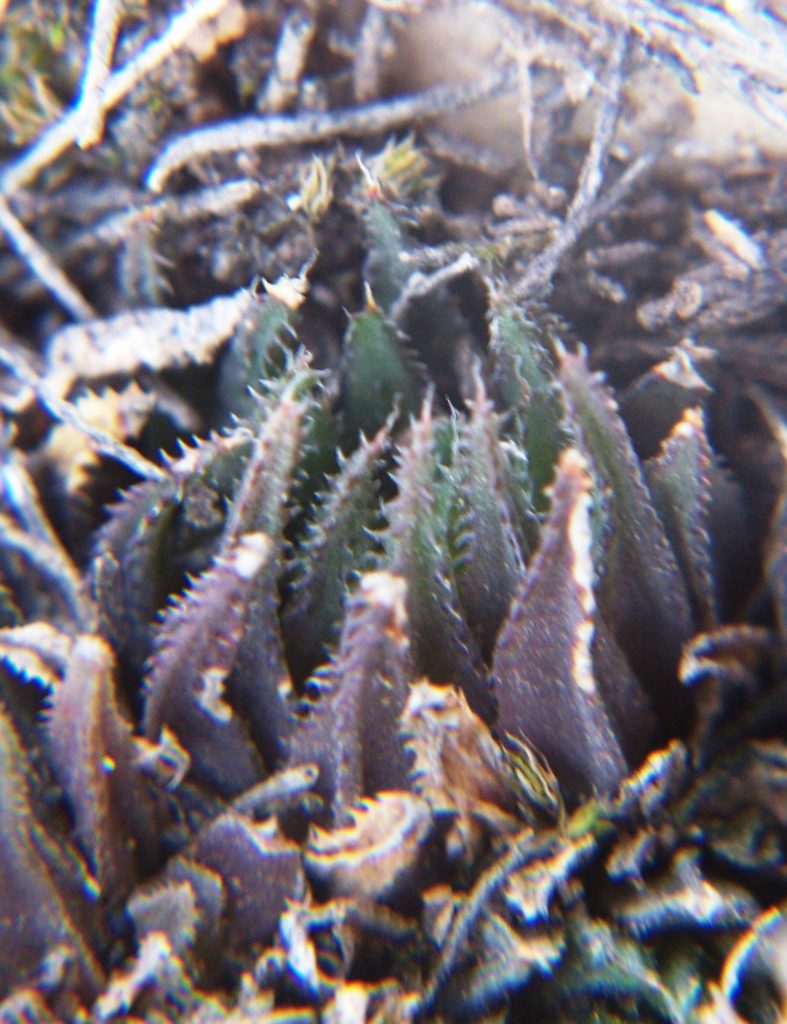122. 2020.04.07 – Like with the present pandemic we are coming to something difficult to comprehend. I went to Botlierskop, Rooiheuwel farm, north of Klein Brakrivier hoping to see a slender long-leaved form of Haworthia chloracantha (a JDV record). Instead I came across this population of rather stubby plants. Keep this population in view – two close populations to follow and then an issue of proximities!
Also on a rock slab about 70 meters away. Is this still chloracantha or is it parksiana?
Frantisek Vesely – We saw the similar situation – on slope there was chloracantha (+ hybrids), on flat a few dozens meters away there was parksiana and its hybrids with chloracantha – not difficult to recognize what happened there as they were so close and mixed up but on one spot most of them were chloracantha-like and the other spot were more parksiana-like plants.
600M away there is a population of uniform parksiana. But how can we say hybrids for the previous? How long have these populations been in existence? Is transfer of pollen a problem and over what distance? There seem to me to be a host of unanswerable questions in general about hybridization as an explanation for variability. It is linked to the more general question of co-occurrence – of mixing or non-mixing of species. Ring clines? Also something we should really try to document – i.e. the proximity of the various species to one another. Add to that the occurrence of hybrids.
123. 2020.04.09 – This population, east of Riversdale, is an aspect that really calls for attention – proximity of kinds (species) and hybridization. At this locality there is H. retusa and H. floribunda in contiguous/adjunct/closely neighbouring populations. Among the floribundas there is a single putative hybrid? How often does this happen and why are kinds (species) so seldom growing together? When is an entire population comprised of hybrids? What comes in between? Let me just add that I see very little in the taxonomic literature dealing with the problems of variability that exist in many genera other than Haworthia. It is simply obscured.

I am quite aware that my comments are often cryptic and often deliberately so. As a society we are very misled and never more so than in respect of the present pandemic. I do not see how we can put that aside and think that we can at the same time depend on our collective intelligence to solve and understand anything else e.g. taxonomy of Haworthia. It is a conscious creation and that consciousness has to be lifted to a level that we see things for what they really are. Hybridity is at the root of species definition and as such a critical step to recognising species. At the same time geographical location is also critical. To to think anything can be explained while there is a paranoia about revealing it, is wishful thinking.
2020.04.12 – There is a problem with classification where priority creates difficulty. The name Haworthia retusa has nomenclatural priority over the name turgida, when in actual fact the turgida form is the main one and retusa is a variant of that. It is much easier to then understand, describe and explain the idea that retusa becomes mutica in the west, retusa and mirabilis become pygmaea in the east, while turgida and mirabilis become emelyae in the Karoo. That might be where I should now leave things. There are a hoard of complexities that just get lost in the needs and activities of the majority who have no need of much more than a lot of desiderata.

























